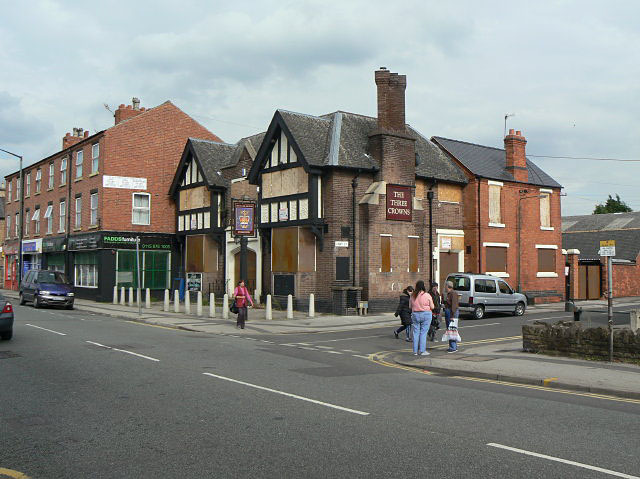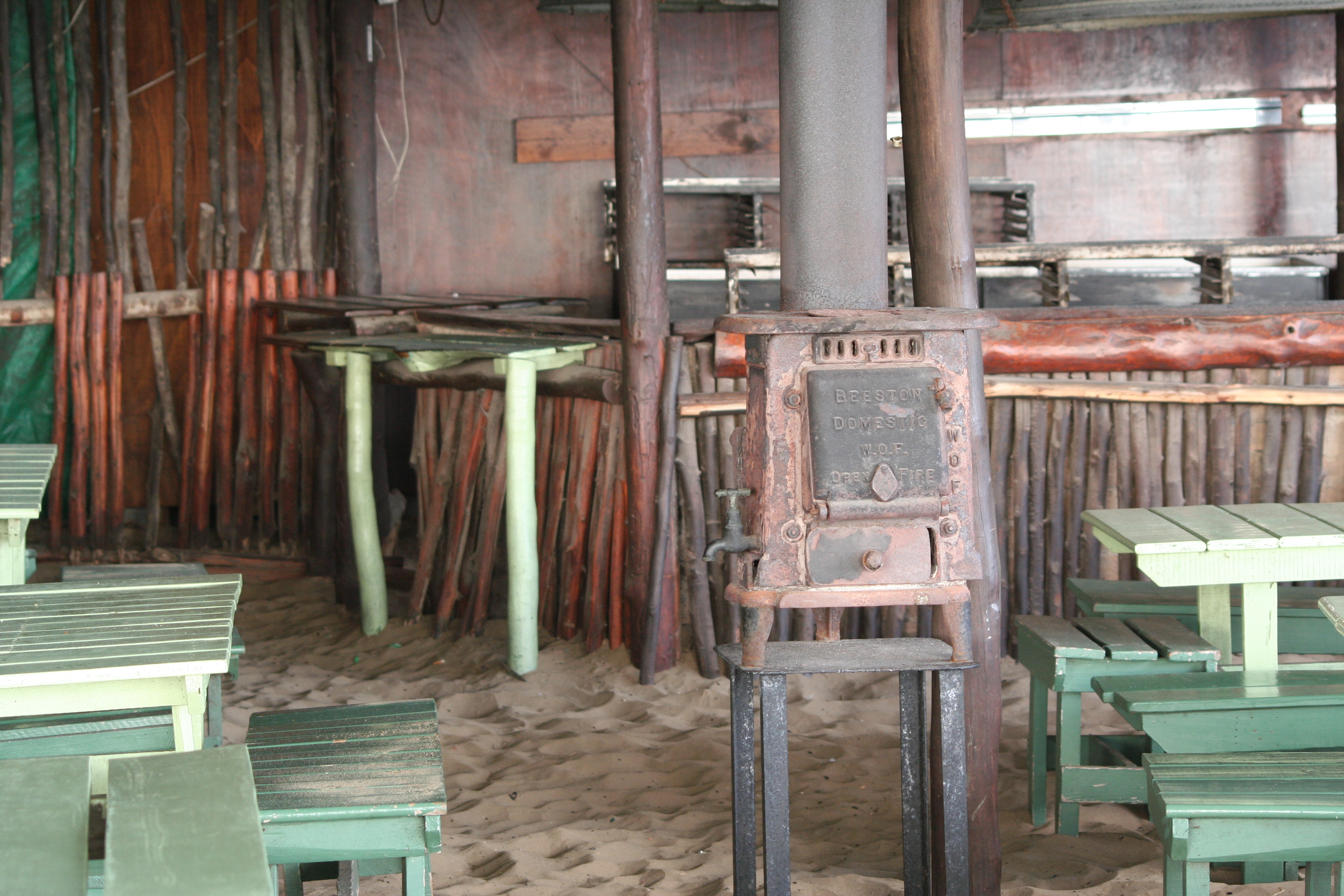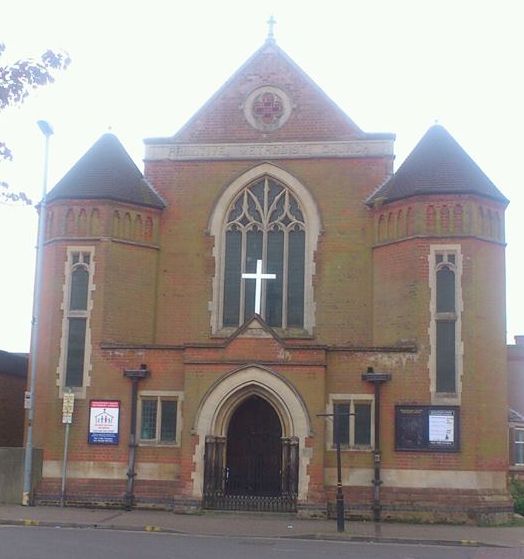|
High Road, Beeston (geograph 1826539)
High Road, Beeston is a pedestrianised shopping street in Beeston, Nottinghamshire. It runs from Beeston Square to Humber Road. History The road was constructed as part of the Sawley to Nottingham turnpike road. In the 19th century, it was on the upper side of the village of Beeston and gained its name, High Road by the middle of the 19th century. By the end of the 19th century it was the principal shopping street, and has remained so into the 21st century. In 1908, Ernest Anthony Bush, the surveyor to Beeston Urban District Council renumbered the properties on the High Road. Starting in 1965, the western end of the street in Post Office Square was redeveloped. All of the buildings on the south side of the street 2-10, including the National Provincial Bank which was only 30 years old, were demolished . In 1987 a sculpture of a beekeeper commissioned by Broxtowe Borough Council and designed by Sioban Coppinger was installed in the street. In 1989 the council installed a sec ... [...More Info...] [...Related Items...] OR: [Wikipedia] [Google] [Baidu] |
Broxtowe Borough Council
Broxtowe refers to a number of geographic entities, current and historic, in Nottinghamshire, England: * Broxtowe, Nottingham, a housing estate in Apsley ward, within the City of Nottingham * Broxtowe (UK Parliament constituency), the constituency with similar boundaries to the borough * Borough of Broxtowe Broxtowe is a local government district with borough status in Nottinghamshire, England, west of the City of Nottingham. The population of the district as taken at the 2011 Census was 109,487. It is part of the Nottingham Urban Area. Broxtowe ..., a local government area in south west Nottinghamshire * Broxtowe Wapentake, a previous division of the county, including, but larger than, the current borough {{disambiguation, geo ... [...More Info...] [...Related Items...] OR: [Wikipedia] [Google] [Baidu] |
Albert Edgar Eberlin
Captain Albert Edgar Eberlin FRIBA MC (18 March 1895 – 13 January 1977) was an architect based in Nottingham. Background and family He was born in Nottingham in 1895, the son of Albert Eberlin (1863-1940), a Chemist in the partnership of Waterall & Eberlin, and also director of the Nottingham Building Society, and Annie Charlotte Maden (1860-1950). He was educated at Nottingham High School and Mill Hill School, Wills Grove, Mill Hill, Hendon. In 1924 he married Edith Annie Daft (1897-1965). In retirement he lived at 122 Sutton Passeys Crescent in Wollaton and he died on 13 January 1977 and left an estate of £68,555 (). Military career During the First World War he served in the 3rd Battalion the King's Own Yorkshire Light Infantry but was later transferred to the 26th Brigade Machine Gun Corps. In 1918 he was awarded the Military Cross for conspicuous gallantry for continued command of his company on 25 April 1918 for over 2 hours whilst under attack despite being shot ... [...More Info...] [...Related Items...] OR: [Wikipedia] [Google] [Baidu] |
Alexander Wilson (architect)
Alexander Wilson LRIBA (26 December 1888 - 30 April 1969) was an architect based in Nottingham. Some of his most significant work include the 900 houses built on the Beeston Rylands estate in the late 1930s. Architectural career He entered into a partnership with Nehemiah Rigley as Architects, Surveyors and Land Agents, based at offices at 13 St Peter's Gate, Nottingham, but this partnership was dissolved in 1926. Later he was based in offices at 45 Burton St, Nottingham. He undertook a significant development in designing 900 houses to be built in Beeston south of Beeston railway station on an 57-acre estate which was then called Cliftonside, but is now known as Beeston Rylands. The houses were built as ‘dwellings for working men’ which at a total cost of £400 () only required an initial deposit of £20 and weekly repayments of 9s 9d. The semi-detached houses comprised a sitting room 11 ft 6in by 10 ft 3in, a living room 2 ft longer, a kitchen/scullery and up ... [...More Info...] [...Related Items...] OR: [Wikipedia] [Google] [Baidu] |
William Vallance Betts
William Vallance Betts LRIBA (1862 – 10 July 1933) was an English architect based in Nottingham. Career He was born in 1862, the son of William Betts (1835–1909) and Mary Vallance (b. 1829). He was articled to Herbert Walker (architect and surveyor), Herbert Walker in Nottingham and later became his assistant. From 1887 to 1888, he was assistant to George Haslam in Ilkeston. Betts commenced independent practice in Nottingham in 1888 and later went into partnership with his son, Albert William Betts. He married Hannah Hoole (1866–1931) in 1888 in Basford, and they had the following children: *Annie Vallance Betts (1890–1981) *Albert William Betts (1892–1963) *Frank Cecil Betts (1895–1963) *Ernest Pollard Betts (1896–1972) *Jennie Betts (b. 1900) *Herbert Betts (1903–1989) Betts died on 10 July 1933 and was buried at Basford Cemetery. He left an estate valued at £11,264. Notable works References {{DEFAULTSORT:Betts, William Vallance 1862 births 1933 ... [...More Info...] [...Related Items...] OR: [Wikipedia] [Google] [Baidu] |
Nottingham
Nottingham ( , East Midlands English, locally ) is a city status in the United Kingdom, city and Unitary authorities of England, unitary authority area in Nottinghamshire, East Midlands, England. It is located north-west of London, south-east of Sheffield and north-east of Birmingham. Nottingham has links to the legend of Robin Hood and to the lace-making, bicycle and Tobacco industry, tobacco industries. The city is also the county town of Nottinghamshire and the settlement was granted its city charter in 1897, as part of Queen Victoria's Diamond Jubilee celebrations. Nottingham is a tourist destination; in 2018, the city received the second-highest number of overnight visitors in the Midlands and the highest number in the East Midlands. In 2020, Nottingham had an estimated population of 330,000. The wider conurbation, which includes many of the city's suburbs, has a population of 768,638. It is the largest urban area in the East Midlands and the second-largest in the Midland ... [...More Info...] [...Related Items...] OR: [Wikipedia] [Google] [Baidu] |
John Bowley
John Bowley LRIBA (26 July 1864 - 28 January 1938) was an architect and engineer based in England who worked mainly in Beeston, Nottinghamshire and Hastings. Architectural career He was educated at University of Nottingham and the Nottingham School of Art. He was articled to J.W. Eardley of Derby from 1881 to 1884 and assistant until 1886 until he moved to be assistant to W.E. Woolley of Loughborough where he stayed until 1889. He then started his own practice in Beeston at lived at 39 Dovecote Lane. In 1896 when he moved to Hastings, initially living at 29 Old London Road. He was appointed Architect to Hastings Town Council. He was also resident engineer to the Eastbourne Waterworks Company and consulting surveyor to the Devonshire Park Company. He was also surveyor to the Compton Estate from 1911 to 1927. He was appointed Licentiate of the Royal Institute of British Architects in 1910. Personal life He was born on 26 July 1864 in Ratclife on Soar, the son of Thomas Cross ... [...More Info...] [...Related Items...] OR: [Wikipedia] [Google] [Baidu] |
High Road, Beeston (geograph 1826539)
High Road, Beeston is a pedestrianised shopping street in Beeston, Nottinghamshire. It runs from Beeston Square to Humber Road. History The road was constructed as part of the Sawley to Nottingham turnpike road. In the 19th century, it was on the upper side of the village of Beeston and gained its name, High Road by the middle of the 19th century. By the end of the 19th century it was the principal shopping street, and has remained so into the 21st century. In 1908, Ernest Anthony Bush, the surveyor to Beeston Urban District Council renumbered the properties on the High Road. Starting in 1965, the western end of the street in Post Office Square was redeveloped. All of the buildings on the south side of the street 2-10, including the National Provincial Bank which was only 30 years old, were demolished . In 1987 a sculpture of a beekeeper commissioned by Broxtowe Borough Council and designed by Sioban Coppinger was installed in the street. In 1989 the council installed a sec ... [...More Info...] [...Related Items...] OR: [Wikipedia] [Google] [Baidu] |
Beeston Superdrug - Geograph
Beeston may refer to: People * Beeston (surname) Places in the United Kingdom *Beeston, Bedfordshire, a hamlet *Beeston, Cheshire, a village and civil parish ** Beeston Castle *Beeston, Leeds, West Yorkshire, a suburb of Leeds **Beeston railway station (West Yorkshire) *Beeston, Norfolk, a village *Beeston Regis * Beeston St Andrew *the former parish of Beeston St Lawrence now part of Ashmanhaugh *the parish of Beeston with Bittering *Beeston Beck (Norfolk), a minor watercourse * Beeston, Nottinghamshire, a town in Nottinghamshire **Beeston railway station **Beeston (UK Parliament constituency) **Beeston Urban District * Beeston Tor, Staffordshire Other uses *Beeston Brewery Company, a brewery based in Beeston, Nottinghamshire (1880–1922) See also *Breaston Breaston ( ) is a large village and civil parish in the Erewash district, in the south-east of Derbyshire and lies approximately east of the city of Derby and west of the city of Nottingham. The population of ... [...More Info...] [...Related Items...] OR: [Wikipedia] [Google] [Baidu] |
Charles Alfred Broadhead
Charles Alfred Broadhead ARIBA (26 July 1880 - 21 May 1962) was an architect mainly working in Rotherham. Architectural career He was articled to William Dymock Pratt of Nottingham in 1897. He was appointed Associate of the Royal Institute of British Architects in 1902. He worked for several years as an assistant in the office of the Nottingham City Architect before taking a similar position in 1913 to the Swansea Corporation at a salary of £250 per annum where he progressed to the position of Acting Borough Architect. In Swansea he lived at 7 Bernard Street. In 1918 he was appointed Borough Architect to the Rotherham Corporation at a salary of £500 per annum (). He had offices in Moorgate Street, Rotherham. Personal life He was born on 26 July 1880 in Basford, Nottingham to John Broadhead (1948- 1905), Lace Warehouseman, and Selina Pywell (1849 - 1930). He married Rebecca Charlotte Bavin (1875 - 1955) in 1907. After his wife's death in 1955, he married Anne Elizabeth Murfin ... [...More Info...] [...Related Items...] OR: [Wikipedia] [Google] [Baidu] |
Frederick Ball
Frederick Ball LRIBA (1861 – 26 July 1915) was an architect based in Nottingham. He was Sheriff of Nottingham from 1906–07, and Mayor of Nottingham from 1913–1914. History He was born in 1861 in Lenton, the third son of George Ball (1823–1887) and Lois Attenborough (1826–1913). His brother, Sir Albert Ball was Lord Mayor of Nottingham. He studied under Richard Charles Sutton and became his assistant until 1880 when he established himself in independent practice in Nottingham. Later he worked in partnership with John Lamb (1859–1949), trading as ''Ball & Lamb'' at 5 Houndsgate, until John Lamb established himself in private practice around 1907. He was appointed Licentiate of the Royal Institute of British Architects in 1911. He was elected to Nottingham City Council in 1902 as representative for Castle Ward. In 1914 his residency was Clumber House, Lenton Avenue, The Park, Nottingham. According to his probate record of 14 December 1914, he died at the Clifton ... [...More Info...] [...Related Items...] OR: [Wikipedia] [Google] [Baidu] |
Beeston, Nottinghamshire
Beeston is a town in the Borough of Broxtowe, Nottinghamshire, England, south-west of Nottingham city centre. To its north-east is the University of Nottingham's main campus, University Park. The pharmaceutical and retail chemist group Boots has its headquarters east of the centre of Beeston, on the border with Broxtowe and the City of Nottingham. To the south lie the River Trent and the village of Attenborough, with extensive wetlands. Origins of the name The earliest name of the settlement was ''Bestune'', recorded in the Domesday Book of 1086. The name derives from the Old English words ''bēos'' (bent-grass) and ''tūn'' (farmstead, settlement). Although the idea that the name derives from the Old English ''bēo'' (bee) is popular locally, this is impossible as the plural form of ''bēo'' would be ''bēon'', resulting in an "n" to historical spellings of the name. The local pastures are still referred to in the name Beeston Rylands. The putative "bee" derivation encour ... [...More Info...] [...Related Items...] OR: [Wikipedia] [Google] [Baidu] |
Thomas Ignatius McCarthy
Thomas Ignatius McCarthy, LRIBA (born 31 January 1880, died 13 Feb 1951) was an architect based in Coalville, Leicestershire. Early in the twentieth century, Thomas Ignatius McCarthy set up a practice as a surveyor and architect in Coalville, which was a partnership shared with Henry Collings (1880 - 1960). Collings was responsible for the design of the Coalville Clock Tower war memorial - a building admired by Pevsner. Examples of work by Thomas Ignatius McCarthy (some possibly in conjunction with Henry Collings): *Primitive Methodist Church, Marlborough Square, Coalville - 1903 *Holy Cross Roman Catholic Church, Parsonwood Hill, Whitwick - 1904 *New Council School, Coalville - 1907 *Nottingham and Nottinghamshire Bank, 19 High Road, Beeston, Nottinghamshire 1908. *Olympia Picture House, Coalville - 1910 (demolished 1933) *South Porch, Saint Andrew's Church, Thringstone - 1911 *The Plaza Cinema, Silver Street, Whitwick - 1914 (destroyed by fire, 1982) *Hosiery Factory, Nor ... [...More Info...] [...Related Items...] OR: [Wikipedia] [Google] [Baidu] |


.jpg)





